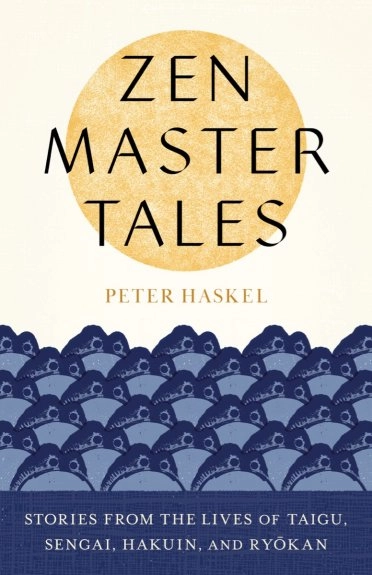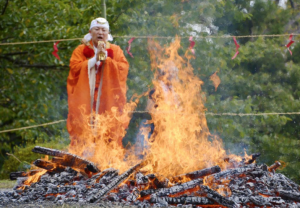The tone of the stories collected in Zen Master Tales: Stories from the Lives of Taigu, Sengai, Hakuin and Ryokan, translated by the renowned scholar Peter Haskel, is appropriately set by the tales of that other master storyteller, Charles Dickens. Perhaps not quite the Zen master we might expect, but an apt reminder nonetheless that these tales are to be understood with a light and open heart. Zen Master Tales is a book of translated stories from Japan’s Edo period (1600–1867)—amusing tales that are worlds away from the Zen we know today. It was a period of relative peace after a century of war and the stories here touch on the societal shifts and challenges of that era. Typically during peacetime, there is a bursting fount of creativity and deep thought. The Edo period was no exception.
As the translator, Haskel reminds us that these Edo-period Zen protagonists are unabashedly real, and nearly all of whom were present and available to every echelon of society, at times exhibiting an almost thigh-slapping sense of pantomime. The significance of women in society during this time, and their attainments of spiritual enlightenment, is also evident through some of these stories, regardless of a nuanced language that mirrored a prevailing patriarchal bias. There seems to be a focus on everyday normality, and on the average human’s ability to awaken to the absolute.
Haskel invites us to bypass the book’s introduction, if we so wish, and dive straight into the marrow—the tales themselves. However, it is worthwhile taking a step into the author’s world first, as Haskel’s introduction shares how the book took seed, explains how and why he selected the tales he did, and takes us through a deeper explanation of the Edo world and the spirit in which these stories were and are to be conveyed. Like all stories, of course, some have morphed over time, and exaggeration has been a proclivity of the human condition since antiquity. These stories are no exception, mainly embellishing in accordance with the prevailing culture. However, this in no way impedes the messages we may still derive from them.
I cannot begin to imagine the hours of research that went into what I read here—or even into a single paragraph. The pages are replete with well-researched provenances and footnotes worthy of a small book in themselves, but all are presented in a cool, relaxed, and easy-to-read, matter-of-fact manner. We are introduced to each master prior to his teachings, which gives us enough insight into his character and the milieu in which he lived, the people with whom he interacted, and in what circumstances.
Contemporary research into the human brain and behavioral patterns tells us that we need to break the established neurological connections that prevent us from recognizing a behavior we prefer. Often, something as simple as stepping outside of our comfort zone is enough to promote growth in such awareness. And it’s at this basic level that we can understand the sometimes quite brutal actions of these masters—a “brutishness” that was almost seen as fashionable by some comfortable classes of the times. I can’t help but think of it almost like high society ladies “slumming it” with the working classes because they can.
But it is more than that, of course. The “brutality” was often considered necessary to snap an arrogant ego, like a rubber band on the wrist—or sometimes on the nose! Sadly, these harsh lessons, beatings, accounts of drinking and occasional debauchery, have morphed into contemporary excuses to legitimize actual abuse by some gurus. There is always room for kindness, words, and deeds of humility and gratitude. So we would be wise to remain mindful of the cultural contexts in which these stories were written, and of those possible exaggerations. We know the psychological damage done to people who, in speaking out about abuse, are repeatedly quashed and ridiculed, and it’s far from enlightening. Even if we understand this beyond our id and ego, reality may well be a mirror. Yet beyond the physical and emotional, beyond the diaphanous, vibrating, super-positioning energy, there’s always room for kindness.
Today, we have so many extraordinary minds sharing deep esoteric wisdom that some Zen tales may even seem blindingly obvious to our educated minds. So I did find myself pondering the passing question: who would count as a Zen master today? Would they have to be ordained? Must they spend years in solitude? Might they be a beggar on the streets? Or a person who challenges you, uncomfortably so? Could they be an anonymous person with whom you interact online? Or are they the eccentric old fool living on the outskirts of normality? Maybe we would innately recognize an awakened mind when we meet one. Maybe we wouldn’t. We might dismiss the beggar on the street, or the fool on the hill, and complain about the person challenging us? Maybe we’re just obsequious sycophants to the person placed on a guru’s pedestal?
However, perhaps more than anyone, we would be wise to follow in the footsteps of Master Ryokan, and take the time to truly relate to and be in the mutual joy of children, spending time to invest in their joy, that they may radiate joy as they grow. Surely few things in our fleeting life are as rewarding? Life during the Edo period may have been harsh at times, but from this side of history, we can romanticize a far simpler life. Perhaps we would be wise to try to live in that simplicity, even if our own reality is more challenging in different ways.
Returning to Zen Master Tales, I know how, ultimately, I will relate to and with Haskel’s collection of translated tales. It will not gather dust. The pages will be akin to the cards of an oracle deck, and the tales lessons on which to reflect. Whether or not one practices Zen, these tales, these koans should be used in the way that they were intended: read, reflected on, and integrated.
References
Haskel, Peter. 2022. Zen Master Tales: Stories from the Lives of Taigu, Sengai, Hakuin, and Ryokan. Boulder, CO: Shambala Publications.
Related features from BDG
Book Review: How We Live Is How We Die by Pema Chödrön
Book Review: Meaningful Life Fearless Death: Spiritual Insights on Death, Dying, Hospice Care and Grief Counseling
Book Review: Threads of Awakening: An American Woman’s Journey into Tibet’s Sacred Textile Art
Book Review: Rebirth: A Guide to Mind, Karma, and Cosmos in the Buddhist World













